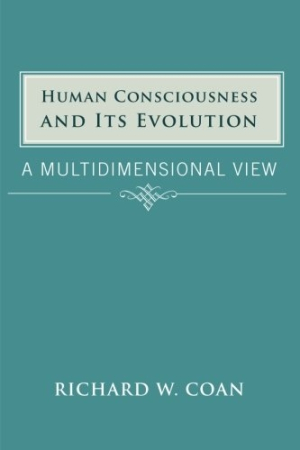Human Consciousness and Its Evolution
A Multidimensional View
This engaging, entertaining survey uses many voices to peek at the future mind of humanity.
“Most of the conspicuous views on the evolution of consciousness appear to be alike in one respect: They are basically unidimensional theories.” Richard W. Coan, professor emeritus of psychology at the University of Arizona, has compiled his own “multidimensional view,” drawing information and inference from many sources in preference to focusing on a central reference point. The resulting work will garner more popular interest than a single-subject treatise, but it is weakened by the author’s refusal to submit his theses to standard academic proofs.
Coan examines the evolution of humankind primarily through religion and philosophy. Most of the world’s spiritual disciplines speak of a higher reality, whether it is called heaven, nirvana, samadhi, or simply “the way.” As one example of changes in consciousness throughout history, Coan points to what he sees as an increased reluctance of young men to make war as a sign of a heightened awareness of the wrongness of killing. This, he argues, is evidence of gradual improvement, or expansion, of human consciousness.
Quoting from Jung, Wilber, Teilhard, Roszak, Jaynes, and the Bible, the author cites vast differences in consciousness along cultural lines (the Japanese are “more emotional than rational”; the so-called bushmen of the Kalahari “maintain telepathic communication with one another”). He posits certain modes of fulfillment of spiritual goals and suggests that flexibility of movement among the modes is a key to evolution of consciousness. Presumably, just as mankind’s consciousness has evolved from its primitive state, it will continue evolving in ways we cannot predict but should consider: “If we leave an adequate record of our own experience, a comparison of our experience with that of our remote descendants will be a possible task of future science.”
Coan, who is a poet, musician, and novelist as well as a professor, writes in an entertaining style. The work is competently organized and neatly formatted, with a library feel. However, organization should not be mistaken for scholarly diligence. The book lacks hard data about the mechanism of consciousness (the brain), instead drawing on psychological, sociological, and spiritual ideas that are not definable in the accepted scientific sense.
Early on, Coan refers to a “theory” as “a work of art.” Even given that proviso, readers could question Coan’s apparent soft spots. For example, he puts credence in the problematic (and some would say defunct) axiom that in the womb, animals develop in physical stages that replicate their evolution as a species.
Citing the largely discredited (because it is racist) pseudo-anthropology of Laurens van der Post regarding the Kung (“bushmen”) is a red flag. The section regarding modes, presumably key to Coan’s thesis, begs a list or chart for clarification. The book is not footnoted. The most current date on bibliographical materials is 1986. Sri Aurobindo, Coan’s source for information about Eastern cosmology, passed away in 1950; surely there are more relevant spokespeople (such as Tenzin Gyatso, fourteenth Dalai Lama) for today’s readers.
Human Consciousness and Its Evolution is an engaging survey and will doubtless be welcomed by those who pursue a perennial study of its subject matter. Readers should bear in mind that it is a notional, not an academic, work despite its author’s credentials.
Reviewed by
Barbara Bamberger Scott
Disclosure: This article is not an endorsement, but a review. The publisher of this book provided free copies of the book and paid a small fee to have their book reviewed by a professional reviewer. Foreword Reviews and Clarion Reviews make no guarantee that the publisher will receive a positive review. Foreword Magazine, Inc. is disclosing this in accordance with the Federal Trade Commission’s 16 CFR, Part 255.

